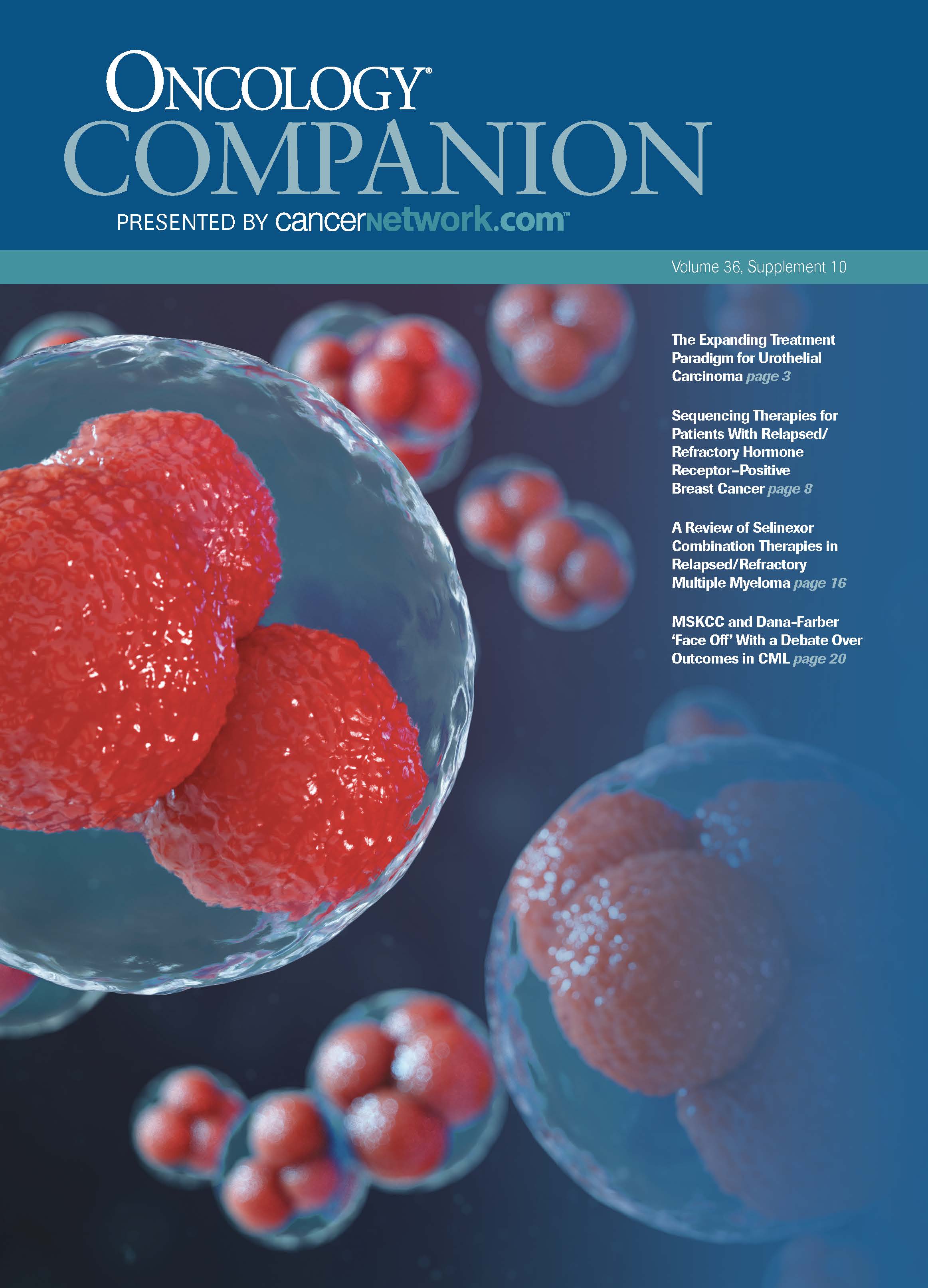Recap: MSKCC and Dana-Farber 'Face Off' With a Debate Over Outcomes in CML
Two teams from leading institutions go head-to-head to debate the latest datasets and advances in chronic myeloid leukemia (CML).

In a recent Face Off program hosted by CancerNetwork®, physicians from Memorial Sloan Kettering Cancer Center (MSKCC) in New York, New York, and Dana-Farber Cancer Institute (DFCI) in Boston, Massachusetts, went head-to-head in a competition-style education program centered on research of treatments for chronic myeloid leukemia (CML). The MSKCC “Yankees” team was led by Michael J. Mauro, MD, leader of the Myeloproliferative Neoplasm Program, while Daniel J. DeAngelo, MD, PhD, chief in the Division of Leukemia at DFCI and professor of medicine at Harvard Medical School, led the opposing “Red Sox” team. Additional commentary during the program was provided by team members Malin Hultcrantz, MD, PhD, assistant attending physician at MSKCC, and Omar Nadeem, MD, clinical director of both the Myeloma Immune Effector Cell Therapy Program and the Center for Prevention of Progression and associate director of Multiple Myeloma Clinical Research Program at DFCI, as well as instructor in medicine at Harvard Medical School.
Each institution reviewed recent studies in CML, allowing the opposing team to ask challenging questions. Each team was awarded points from a live audience after each set of responses, determining a winner at the end of the presentation.
MSKCC: OPTIC and PACE Trials
OPTIC Trial
The phase 2 OPTIC trial (NCT02467270) evaluated ponatinib (Iclusig) in patients with chronic-phase CML (CP-CML) who were intolerant or resistant to at least 2 prior BCR-ABL1 tyrosine kinase inhibitors (TKIs) or with a BCR-ABL1 T315I mutation.1 Patients (n = 232) were randomized 1:1:1 and received ponatinib at either 45 mg, 30 mg, or 15 mg once daily. The best response to prior therapy was complete hematologic response or worse in 61% of patients.
The primary end point of molecular response, defined as 1% or less of BCR-ABL1IS at 12 months, was met in the 45-mg cohort with a rate of 44.1% (98.3% CI, 31.7%-57.0%; P <.017). In the 30-mg and 15-mg cohorts, those rates were 29.0% (98.3% CI, 18.4%- 41.6%) and 23.1% (98.3% CI, 13.4%- 35.3%), respectively. In the 3 cohorts, the major molecular response (MMR) rates were 34.4%, 24.7%, and 23.1%, with the major cytogenetic response (MCyR) rates being 50.5%, 33.3%, and 43.8% in the 45-mg, 30-mg, and 15-mg cohorts, respectively.
In the 45-mg and 30-mg cohorts, the median progression-free survival (PFS) was not reached, but it was 45.6 months in the 15-mg cohort. At 24 months, the median PFS rates were estimated to be 80%, 76%, and 78% in the 45-mg, 30-mg, and 15-mg cohorts, respectively. The median overall survival (OS) was not reached in any cohort, with OS rates expected to be more than 90% at 24 months in all 3 cohorts.
The most common nonhematologic treatment-emergent adverse effects (TEAEs) were arterial hypertension (28%), headache (18%), and lipase increase (17%) in all cohorts combined. The most common hematologic TEAEs were thrombocytopenia (40%), neutropenia (26%), and anemia (19%).
PACE Trial
The phase 2 PACE trial (NCT01207440) investigated ponatinib in patients with Philadelphia chromosome–positive CML or acute lymphoblastic leukemia who were resistant or intolerant to dasatinib (Sprycel) or nilotinib (Tasigna) or who had prior TKI use and a BCR-ABL1 T315I mutation.2 The trial aimed to better understand arterial occlusive events (AOEs) that occurred with use of ponatinib. Patients were given ponatinib at 45 mg once daily and could reduce it to 30 mg or 15 mg to manage AEs.
AOEs were categorized as being adjudicated or nonadjudicated if they were recorded as symptoms with a low level of severity and no change in medication. A total of 449 patients were enrolled; 17% had adjudicated AOEs and 25% had nonadjudicated AOEs. Serious adjudicated vs nonadjudicated AOEs occurred in 20% vs 16%, respectively. Baseline risk factors for developing AOEs included arterial hypertension and hypercholesterolemia.
Eleven adjudicated AOEs were associated with death: 2 cases of cardiac arrest and 1 each of bradycardic arrest, cardiac failure, intracranial hemorrhage, worsening of congestive heart failure, superior mesenteric artery occlusion, hemorrhagic cerebral infarction, congestive heart failure, ischemic stroke, and acute anterior myocardial infarction. Nine of those 11 patients had a history of cardiovascular events.
Yankees at Bat: DFCI Challenges MSKCC
DEANGELO: [In the OPTIC trial], was switching to a lower dose optimal for patients who had a cytogenic remission?
MAURO: Most of these patients entered with poor clinical status. Most of them were with CHR [complete hematologic response with their last therapy] or less, meaning that if they had a cytogenic remission it was a significant distance they covered. We know cytogenic remission is a safe remission. However, when I use ponatinib I wait until patients achieve an MMR [to reduce the dose]. While I think it was reasonable in this study—and probably a fairly large number of studies show that cytogenetic remission does offer protection against the risk of progression, which is our most important goal—this is a tough population. I wonder whether waiting until patients have deeper remissions may be a safer strategy.

NADEEM: What about the use of antiplatelets or anticoagulants in these trials? Is this something that’s looked at [regarding] impacts to the risks of all thrombotic events?
MAURO: I’m not aware of any trials that systematically add antiplatelet, lipid-lowering, or other interventions in the setting of CML therapies, or other therapies for that matter, with vascular toxic risk. That’s based on the challenges [presented by] the number of patients you would need to have in a study to prove that your intervention was meaningful. If you look at the cardiovascular literature for primary prevention with aspirin, for example, you need tens of thousands of patients to show a difference, and there aren’t that many outpatients with CML to power a study. The best approach is to make sure these patients with CML have proper cardiovascular risk assessment and risk intervention. Many patients who have dyslipidemia may need aspirin for either primary or secondary prevention and are not on it. I believe that in PACE and other trials, they have looked at patients who are on cardiovascular-protective strategies, and that didn’t necessarily predict AEs.

HULTCRANTZ: Is there any overlap between patients with myeloproliferative neoplasms (MPNs) who have a high risk of thrombosis and those with CML who are given aspirin?
MAURO: Patients with MPNs have a thrombotic phenotype from the myeloid mutations they carry, which clonal hematopoiesis research has proven is a risk for cardiovascular disease. Our patients all have them. Many of them have driver mutations plus the ones that have been studied. It’s a separate issue. At presentation, patients with CML are at a risk for vascular events, such as priapism ocular disease, and a number of [other] different things that aren’t discussed often because we don’t see them as much. Once you get them on therapy, their platelet function and their bleeding diathesis normalize.
DFCI: ASCEMBL and PACE/OPTIC Trials
ASCEMBL Trial
The phase 3 ASCEMBL trial (NCT03106779) assessed asciminib (Scemblix) at 40 mg twice daily vs bosutinib (Bosulif) at 500 mg once daily in patients with CP-CML who had been treated with 2 or more TKIs.3 A total of 223 patients were randomized 2:1 to active or control therapy with a median follow-up of 14.9 months. At baseline, MCyR was observed in 29.3% of patients in the asciminib arm vs 28.9% in the bosutinib arm. After the data analysis cutoff date, treatment was ongoing in 61.8% vs 28.9% of patients, respectively, with 37.6% and 71.1% discontinuing therapy.
The 24-week MMR rate was 25.5% in the asciminib arm and 13.2% in the bosutinib arm, equating to a 12.2% difference between groups after adjusting for baseline MCyR rates (95% CI, 2.19%-22.30%; 2-sided P = .029). The cumulative incidence of MMR at week 24 was 25.0% in the asciminib arm vs 12.0% in the bosutinib arm.
Grade 3 or higher AEs occurred in 50.6% of patients in the asciminib arm vs 60.5% in the bosutinib arm, with treatment-related AEs being reported in 63.5% and 88.2%, respectively. The most common grade 3 or higher AEs leading to treatment discontinuation included thrombocytopenia (3.2%) in patients receiving asciminib and increased alanine aminotransferase (3.9%) in those receiving bosutinib.
Ponatinib Given After Failure of Second-Generation TKI
Analysis from Hagop M. Kantarjian, MD, and colleagues focused on cumulative results of safety and efficacy of ponatinib from the PACE (n = 257) and OPTIC (n = 93) trials in patients with CP-CML following failure of prior second-generation TKI treatment.4 The median follow-up was 57 months in the PACE trial and 32 months in the OPTIC trial, with a median 24-month dose intensity of 30 mg for PACE and 15 mg for OPTIC.
Achievement of less than 1% BCR-ABL1IS response occurred in 42% at 12 months, 46% at 24 months, and 47% at 60 months in the PACE trial. In the OPTIC trial, 52% and 57% of patients had the same response at 12 and 24 months, respectively. The 2-year PFS and OS rates in the PACE trial were 68% and 85% respectivley. In the OPTIC trial, they were 80% and 91%, respectively.
In patients who received 2 or more TKIs, the 12-month and 24-month rates of response at less than 1% BCR-ABL1IS in PACE were 39% and 41%, respectively. In the OPTIC trial, corresponding rates were 55% and 57%, respectively. The 2-year PFS and OS rates were 66% and 88%, respectively, in the PACE trial compared with 73% and 88% in the OPTIC trial.
TEAEs of grade 3/4 occurred at a rate of 81% each in those with 2 or fewer or 3 or more prior TKIs in the PACE trial; in the OPTIC trial, those rates were 67% and 66%, respectively. Grade 3 or 4 treatment-emergent AOEs occurred in 12% and 9% of patients in the PACE trial with 2 or fewer or 3 or more prior TKIs vs 5% and 6% in the OPTIC trial.
Red Sox at the Plate: MSKCC Challenges DFCI
MAURO: In the ASCEMBL trial, if we leveled the playing field between the asciminib and bosutinib doses, what might the AEs look like?
DEANGELO: We don’t start our patients on 500 mg [of bosutinib]. In fact, we typically ramp up our [doses] to have better tolerability. That wasn’t allowed in this study and that’s a huge criticism. If you had started a patient at 200 mg, 300 mg, or 400 mg vs 500 mg—which is what I usually do—it’s unclear if [the patients] would’ve gotten better tolerability. More is not always better in all of these drugs. As you know, imatinib [Gleevec] may be the exception, as the OPTIC trial showed, but almost all the FDA-approved drugs have the option to dose reduce. I do think the tolerability may have suffered in this trial, but I don’t think the conclusion should [dissuade clinicians from using] asciminib—at least in patients who have failed second-generation TKI, especially multiple second-generation TKIs—is better than moving on to a third like bosutinib.
MAURO: Can you discuss the 6-month MMR in the ASCEMBL trial? Was it appropriate or should it have been a later time point?
DEANGELO: In your presentation last year, you showed the longer-term data of 48 weeks and 96 weeks, which were the secondary end points and are important.5,6 There are fewer patients on the bosutinib arm out that far. Not only do patients continue to respond to asciminib, but the difference between the responses with asciminib vs bosutinib in this case increased. You’re saying 24 weeks may not be the right thing, although you can argue that maybe 48 weeks is a better end point than 24 weeks. Undoubtedly, faster responders do better than slower responders. The data that I showed took that out to 96 weeks and supported that.
MAURO: Is it fair to compare ponatinib vs asciminib in these populations?
DEANGELO: No—that’s why you’re never supposed to compare studies, because of different patient populations and different eras. It is important to note that we have 5-year data in the PACE trial and we have long-term data in the OPTIC trial. We don’t have long-term trial data in the ASCEMBL study. Long-term follow-up is going to be important. In the ASCEMBL study, so few patients are left on the control arm. If you look at just the asciminib arm [efficacy] looks comparable, but we have longer data with the ponatinib [arm]. There’s something to be said about a study that can go out 5 years and show patients who responded, and these were heavily pretreated patients with a response that is durable, and we just don’t have the same luxury of data on the ASCEMBL study.
Stay tuned for our next installment of Face Off, where the MSKCC Yankees and the DFCI Red Sox will debate multiple myeloma and the winner will be determined.
References
- Cortes J, Apperley J, Lomaia E, et al. Ponatinib dose-ranging study in chronic-phase chronic myeloid leukemia: a randomized, open-label phase 2 clinical trial. Blood. 2021;138(21):2042-2050. doi:10.1182/blood.2021012082
- Januzzi JL, Garasic JM, Kasner SE, et al. Retrospective analysis of arterial occlusive events in the PACEtrial by an independent adjudication committee. J Hematol Oncol. 2022;15(1):1. doi:10.1186/s13045-021-01221-z. Published correction appears in J Hematol Oncol. 2022;15(1):33.
- Réa D, Mauro MJ, Boquimpani C, et al. A phase 3, open-label, randomized study of asciminib, a STAMP inhibitor, vs bosutinib in CML after 2 or more prior TKIs. Blood. 2021;138(21):2031-2041. doi:10.1182/ blood.2020009984
- Kantarjian HM, Jabbour E, Deininger M, et al. Ponatinib after failure of second-generation tyrosine kinase inhibitor in resistant chronic-phase chronic myeloid leukemia. Am J Hematol. 2022;97(11):1419- 1426. doi:10.1002/ajh.26686
- Rea D, Mauro MJ, Hochhaus A, et al. Efficacy and safety results from ASCEMBL, a phase 3 study of asciminib versus bosutinib (BOS) in patients (pts) with chronic myeloid leukemia in chronic phase (CML-CP) after ≥2 prior tyrosine kinase inhibitors (TKIs): week 96 update. J Clin Oncol. 2022;40(suppl 16):abstr 7004. doi:10.1200/JCO.2022.40.16_suppl.7004
- Mauro MJ, Minami Y, Rea D, et al. Efficacy and safety results from ASCEMBL, a multicenter, open-label, phase 3 study of asciminib, a first-in-class STAMP inhibitor, vs bosutinib in patients with chronic myeloid leukemia in chronic phase after ≥2 prior tyrosine kinase inhibitors: update after 48 weeks. Blood. 2021;138(suppl 1):310. doi:10.1182/blood-2021-152561
EP: 1.Team Introductions: Memorial Sloan Kettering “Yankees” vs Dana-Farber “Red Sox”
EP: 2.The OPTIC Trial: A Ponatinib Dose-Ranging Study in Chronic Myeloid Leukemia
EP: 3.Chronic Myeloid Leukemia: Arterial Occlusive Events in the PACE Trial
EP: 4.Cross Q&A: Team Memorial Sloan Kettering
EP: 5.Asciminib vs Bosutinib in Chronic Myeloid Leukemia Treatment
EP: 6.Ponatinib after TKI Failure in Chronic Myeloid Leukemia
EP: 7.Cross Q&A: Team Dana-Farber
EP: 8.Recap: MSKCC and Dana-Farber 'Face Off' With a Debate Over Outcomes in CML
